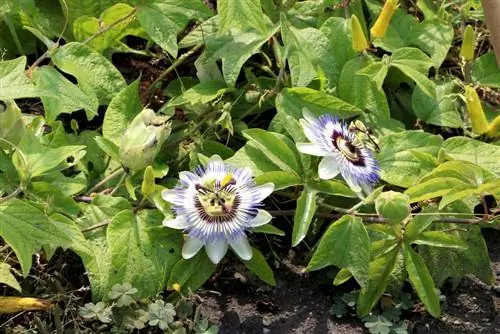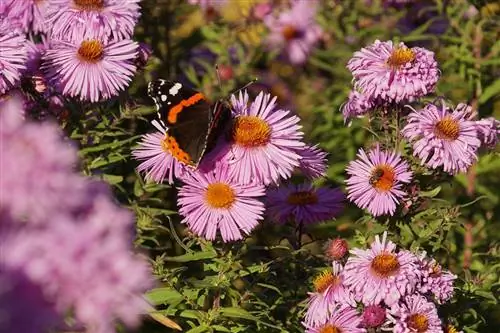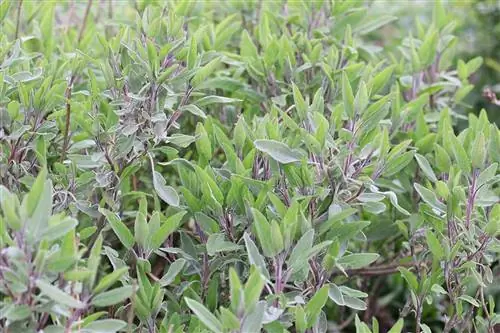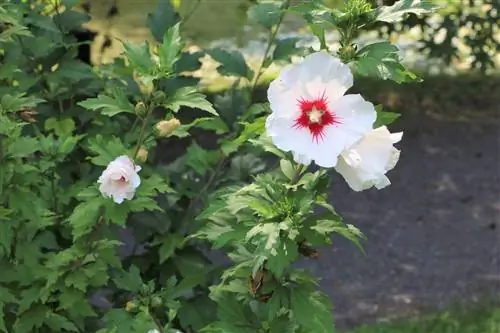- Author admin [email protected].
- Public 2023-12-17 03:39.
- Last modified 2025-01-24 12:45.
The popularity of passionflower has been increasing for years. It is one of the easier-care plants that decorate gardens, terraces and balconies. But one important aspect plays a decisive role and determines development: cutting. This is where many hobby gardeners make mistakes and wonder why their passiflora is not thriving as desired. The plant expert explains how to do it right.
Pruning reasons
Stimulation of flower formation
Hardly any plant reacts with significantly improved flower production like the passionflower plant. Flowers only grow on young shoots. Over the years, these become woody and deprive new shoots of the opportunity to grow. Correctly carried out pruning at the ideal time can promote branching of new shoots. The more widely the new shoots sprout, the more extensively flower buds can spread.
In addition, the passiflora can quickly reach a height of up to ten meters. This requires a high supply of nutrients, which in many cases leads to a restriction in flower formation.
More fruits
If many flowers have developed, this is of course also noticeable in fruit formation. Most of the passion flowers available in local regions have fruits that are not edible, but at least visually they exude a unique Mediterranean flair and are therefore desirable in large quantities.
Dense growth
Passion flowers have several strong leading shoots that become woody from the second year of life. They form the basis. The longer they get, the weaker they become if they are not regularly strengthened by shortening them. As a result, leaf growth and especially the formation of new shoots decrease. The plant becomes thinner and thinner, flowers fail and it becomes increasingly unsightly. Cutting the passiflora prevents this and ensures that dense growth follows.
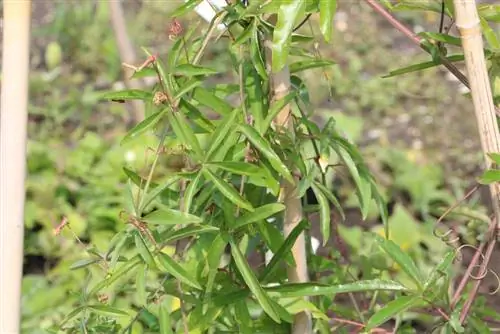
Longer, he althy life
The formation of flowers, fruits and seeds puts an immense strain on the passion flower plant. During this vegetation phase, the nutrient requirement increases and the plant loses strength and resistance. You can prevent this by cutting and help the plant survive this time much better. She will thank you with a he althy appearance and a long lifespan.
Cutting for overwintering
The Passifloraceae grows relatively quickly under ideal husbandry and care conditions. As a tendril plant, it climbs in all directions. A height of ten meters is not uncommon, if this is desired. This often makes it a problem when the predominantly cold-sensitive plant has to be relocated for overwintering. Pruning is therefore the solution, although the most important thing here is when and how you cut.
In addition, by pruning before overwintering you can create the best conditions for the start of growth in the following year by giving it a relaxed winter rest - because the following applies: the fewer parts of the plant that need to be taken care of in winter, the better the passion fruit will do. Plant through the winter.
In case of illness
If the passion flower is sick or, for example, parasites have attacked it and made it extremely weak, in the worst case scenario this can cost it its life. In order to best support it in its recovery and/or to help it regain its strength, a special pruning can often work wonders and prevent it from dying completely. All that matters is the right cutting technique!
Topiary and height/width correction
If you only have limited space for your passion flower or if it grows unevenly, topiary or height and width correction will ensure the desired dimensions and lines.
Best time to cut
Basically, passionflower can be cut in early autumn or in spring after the last frost. First and foremost, it depends on the reason for which you want to cut.
Autumn cut
To stimulate flowering and dense growth, both times are suitable. It is important that the pruning is carried out after the flowers have wilted or the fruit has been harvested and before the first cold snap. The beginning of October is usually the ideal time for pruning.
Spring cut
In spring, the beginning of the growing season should be imminent and there should be no buds yet, which can usually form as early as mid-May, depending on the weather conditions. Accordingly, the perfect time to prune is directly after the Ice Saints. In exceptional cases, cutting can also be carried out after the start of vegetation and flower formation.
When to cut in autumn?
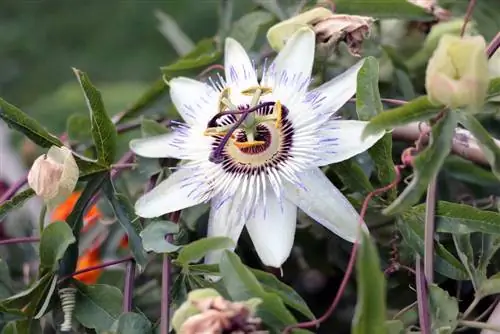
Pruning can/should be done in autumn for the following reasons:
- In the event of illness and weakened condition, in order to get through the winter rest without damage
- For size adjustment when moving to winter quarters
- Light foliage and/or growth disorders
- Promotion of flower formation
- The plant should be protected by avoiding fruit formation (cut immediately after flowering at the end of August/beginning of September)
When to cut in spring?
Pruning is recommended in spring, especially if the following points apply:
- There was no cutting in the fall
- The plant suffered damage during overwintering
- Shoots that are too thin are formed
- Only a few or no buds are visible (cut after the start of vegetation)
- Topiary
- In case of illness (pruning time if necessary throughout the garden season)
Cutting instructions
Denser growth and stimulation of bud formation
In order to achieve denser growth, the side shoots must be shortened. From this, branches of new shoots develop, which offer more space for foliage and flowers. The more branches and thus new shoots can arise, the denser and more flowery the passion flower will be.
When cutting, proceed as follows:
- In the fall, shorten all the shoots that have formed that year
- Cut these back to three to five eyes
- Older, woody shoots should be shortened by a few centimeters to give them more strength
- Short dry and sparse shoots radically at the budding point
- Cut off crossing shoots there so that they no longer overlap
- Ideally, you should cut off the shoots with wilted flowers in early autumn, as they take up a lot of energy
Pruning before overwintering
Pruning is not absolutely necessary for optimal overwintering. In contrast to many other plants, passiflora can tolerate even radical pruning, although this is usually a major burden. You can trim the plant to any height and width so that it can, for example, spend the winter on the windowsill in an unheated bedroom or in the smallest of spaces in the winter garden.
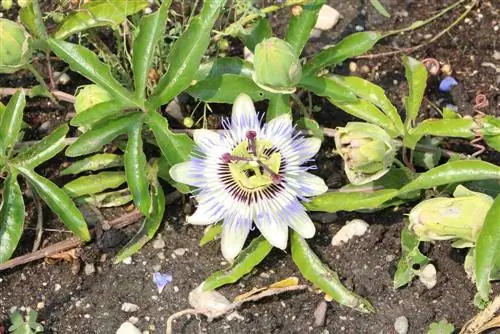
A radical cut is particularly recommended if, in addition to reducing the size, you want to promote flower and fruit formation and/or want denser growth in the next garden season. With radical pruning, you cut everything back, including the leading branches, to around 15 to 20 centimeters. Due to its rapid growth, your specimen will sprout again quickly and, above all, vigorously in the spring.
Radical cut in spring
You should avoid radical pruning in the spring, as you can do for overwintering - exception: your plant is sick and a radical pruning promotes recovery. Cutting back too deeply in spring would delay flower formation and affect the natural rhythm. This means that it could bloom too far into autumn and therefore prepare for hibernation too late. Here you run the risk of not being able to collect enough reserves for the cold season and getting through the winter weaker.
Radical cut in case of illness
If the passionflower plant has been severely weakened due to illness or pest infestation, a radical cut is the optimal support for a quick recovery. This is because a plant that is cut short requires less energy and nutrients to ensure the supply of all parts of the plant. After a radical cut, the plant can recover better and invest the newly gained energy evenly and in a well-dosed manner in the formation of new shoots. As a result, she grows up he althy and strong again. In the event of illness or significant weakness, a radical cut is possible at any time between spring and moving into winter quarters.
Topiary and size correction
Passion flowers grow an average of two meters per year. Depending on how evenly the sunlight falls on it, it can have different growth speeds in all directions. In order to bring them back into shape and, above all, to let them rise evenly on a tendril, the shape and height/width pruning should be done in spring. Here you cut off all protruding shoots to the same height. Further shape corrections can be made during the summer as long as they are limited to just a few centimeters and no flowers are affected.
The right cutting tool
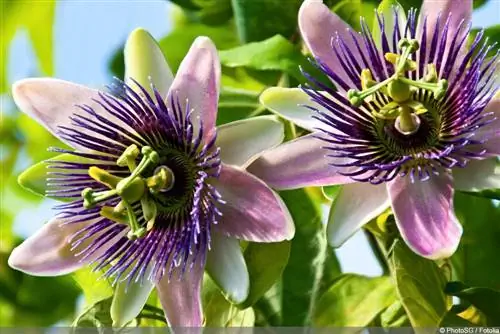
When cutting back a passion flower, it is important that you only use a sharp and clean cutting tool. With dull knives and scissors you cause bruises on the remaining shoots, where the cut heals more slowly. This in turn increases the risk of fungal infections. Bacteria, viruses and pests can also be transmitted to the passiflora through infected cutting tools. This can have fatal consequences, especially when pruning in autumn and, in the worst case, cause the vine plant to die over the winter. Therefore, disinfect the cutting tool before use. There are various options available to you:
- Spray the blades from all sides with a household disinfectant spray (for example with Sagrotan)
- Boil the cutting tool in a pot of water for at least ten minutes
- Wet the blades with spirit and hold them in the flame of a Bunsen burner for around two minutes

